
Our work focuses on the flora of the Intermountain West, with a particular focus on two ecoregions in Utah - the Colorado Plateau and the Great Basin. The majority of our projects occur within Utah, although we do occasionally venture into neighboring states.
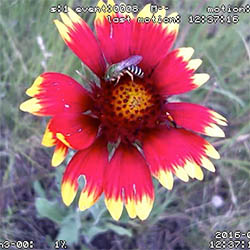
Project: Monitoring Pollinator Activity with Rana
Duration: Ongoing
Summary: We are using a new automated motion-capture technology called Rana to track and record pollinator activity on selected native plant species. This project will allow us to determine the diversity and frequency of insect visits on certain types of flowers, and help answer important questions about pollinator services and "pollinator-friendly" plants in Utah. We have used Rana cameras for studies at the Rio Mesa Center outside of Moab, UT, in areas surrounding St. George, UT, as well as in the Natural Area and Children's Garden here at Red Butte Garden, and recorded visits of many different kinds of native bees, butterflies, and even hummingbirds. To watch a video of pollinators visiting flowers at Red Butte Garden, Click Here!
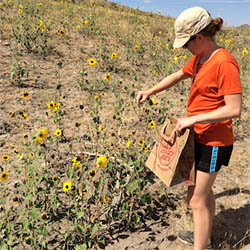
Project: Seeds of Success (SOS)
Partners: BLM and Colorado Plateau Native Plant Program (CPNPP)
Duration: Ongoing
Summary: Each year we survey an ecological region for abundant, native plants from which seed can be collected. In 2015, we completed nearly 30 collections totaling 1.2 million seeds from 14 native Great Basin plant species. Seeds are stored at the Bend Seed Extractory for future use in habitat restoration and rehabilitation. Herbarium specimens are also collected, which are divvied up between Red Butte Garden, the University of Utah, Brigham Young University, and the Smithsonian Institute. Click here for photo highlights from past SOS Collection years!
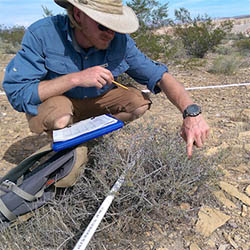
Project: Blackrock Gypsum Vegetation Surveys and Rehabilitation Analysis
Partners: BLM, U.S. Fish and Wildlife Service, and Blackrock Gypsum
Duration: Completed in 2015
Summary: We surveyed habitat surrounding the Endangered Gierisch's globemallow (Sphaeralcea gierischii) population in Arizona to piece together the rehabilitation history of post-gypsum mining landforms. We compared vegetation structure and composition between rehab and adjacent undisturbed control sites to examine the effects of past practices, seed mixes and the gypsum-rich substrate on the success of restoration in this area.
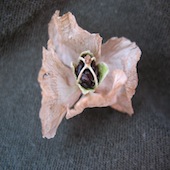
Project: Rare and endangered seed collection for ex-situ conservation, a.k.a. seed banking
Partner: BLM and Center for Plant Conservation (CPC)
Duration: Ongoing
Summary: Seed banking is a long-term method for conserving the diversity of plant species. Seeds of rare, threatened and endangered plants are collected and stored with low moisture content at low temperatures, thereby extending their lifespan. These collections preserve genetic material away from the threat of habitat destruction. We store a portion of seed in our on-site seed bank; another portion is sent to the National Center for Genetic Resources Preservation in Fort Collins, CO.
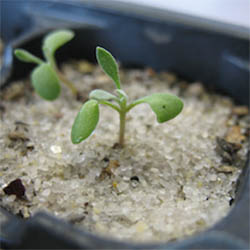
Project: Germination and Propagation Trials
Partner: BLM and Center for Plant Conservation (CPC)
Duration: Ongoing
Summary: At the garden, we are currently testing seeds from our seed bank in order to develop the best protocols for germinating rare plant species. Once seeds have germinated, we maintain them in our greenhouses and track their growth each month in order to pinpoint the best methods for propagation. Many of the species we work with require very specific conditions for growth, and by sustaining these species in our greenhouses, we can determine the feasibility of growing seedlings for future outplanting and restoration studies. Learn more about our current trials here!
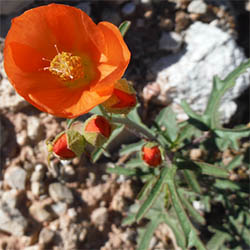
Project: Sphaeralcea gierischii (Gierisch's globemallow) propagation and reintroduction
Plant Status: Listed Endangered
Threats: Gypsum mining and off-road vehicle recreation
Partner: BLM, U.S. Fish and Wildlife Service
Duration: Completed in 2015
Summary: We conducted in-situ germination studies at a trial reintroduction site to assess the feasibility of reintroducing this species to rehabilitated mining substrates from seed. We monitored seedling establishment and tracked seedling survivorship from 2013-2015 on study sites in Arizona. We also collected seed for long-term ex-situ conservation and developed greenhouse propagation protocols. This species was listed as endangered in 2013, a decision that was informed by our data.
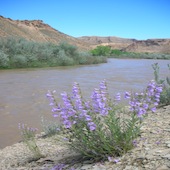
Project: Penstemon grahamii (Graham’s beardtongue) and Penstemon scariosus var. albifluvis (White River beardtongue) long-term demographic and population monitoring
Threats: Oil and gas exploration, tar sand and oil shale mining, off-road vehicle use, and grazing. All threats are exacerbated by small population sizes and limited distribution.
Partner: BLM
Duration: Initiated in 2004, completed in 2015
Summary: Over the ten consecutive years of this monitoring project, we have collected demographic and population trend data from these species to inform management decisions. The project has grown to include propagation studies, ex-situ care of living specimens, and seed collection for ex-situ conservation.
What is biodiversity?
Biodiversity is the number of different species of plants and animals found within a particular region, or ecosystem. The more diverse an ecosystem, meaning the more plants, animals, insects, and bacteria living within it, the healthier it is. A diverse ecosystem has more resources to draw on that allow it to bounce back from disturbances, adapt to long-term changes, and support the communities within it, wild or cultivated.
Why does it matter?
While biodiversity is critical for the sake of the environment in and of itself, there are a number of reasons biodiversity should matter to our species. To focus just on plant diversity: plants provide us with key ingredients and products that feed us, shelter us, keep us healthy, and fuel our economy. To destroy a species, actively or unknowingly, is to destroy its potential for tomorrow and for generations to come. Read "Why Diversity Matters" from NatureServe.
What are our goals?
We are stewards of the at-risk plants in our region, and protecting them is a key component of Red Butte Garden’s mission. We hope to mitigate threats and preserve genetic information so that rare populations may recover in their native habitats, thereby conserving the diversity of our native flora.
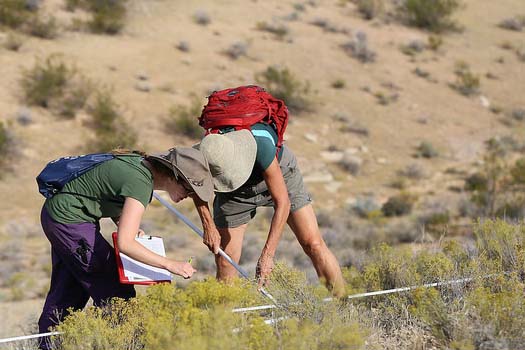
What kind of work do we do?
In-situ conservation is work that is done on site, in the area where the plant naturally grows. We collect plant samples and seeds to study later, monitor populations, transplant endangered species out of harm’s way, and re-vegetate with seeds or seedlings in their native habitats.
Ex-situ conservation is work that is done off site, at our garden facility or other facilities around the West. This work involves storing seeds in seed banks to preserve the genetic material, testing seed germination and viability to better understand how to propagate a species, and caring for living specimens that have been propagated or salvaged from project sites.
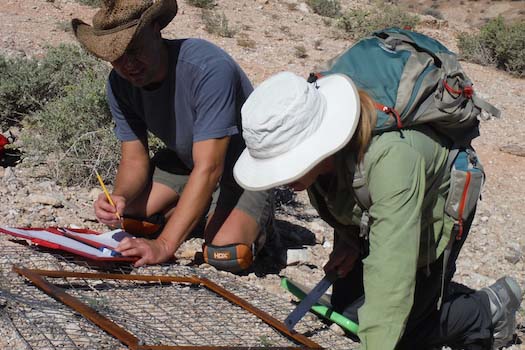
Volunteer:
Your time and experience are valuable to us. Whether you’re a novice naturalist or a committed conservationist, we can use your help! If you’re interested in volunteering in Conservation or anywhere else at Red Butte Garden, contact our Volunteer Coordinator, Lauren Miller, or check out the Volunteer Opportunities page.
Franny Johnson, Volunteer Coordinator
Email: franny.johnson@redbutte.utah.edu
Volunteers help with a wide variety of projects, many of which are seasonal. They include plant surveying and seed collection; cleaning, sorting, and banking seeds; rare plant curation and propagation; and general greenhouse and office help. Training in the field is provided. Volunteers must be 18 years or older.
Plant Natives, Pull Invasives:
Your land, however small, can be an important piece of habitat for native plants, pollinators, and other wildlife. As our cities expand outward, eating up true native habitats, these oases become critical to support native populations.
What to Plant:
- Gardening for Native Bees in Utah from USU Cooperative Extension
- Ecoregional Planting Guides from The Pollinator Partnership
- Native Plant Resources from the Utah Native Plant Society
What to Pull:
Utah’s Noxious Weed List from the Utah Weed Control Association
Donate:
We can’t do it without your support. Making a donation to the Garden supports our efforts to protect and restore threatened plant communities throughout Utah.
- Center for Plant Conservation
- Seeds of Success
- Utah Native Plant Society
- Utah Natural Heritage Program
- U.S. Department of the Interior, Bureau of Land Management
- U.S. Fish and Wildlife Service
- U.S. Forest Service
- National Parks Service
- National Center for Genetic Resources Preservation
- Colorado Plateau Native Plant Program
- Rio Mesa Center
RED BUTTE GARDEN CONSERVATION DEPARTMENT
Red Butte Garden Conservation Efforts at The University of Utah Read the article
NATIVE PLANT MATERIALS RESEARCH
- February 2016, "To Prevent Another Dust Bowl, the US Must Sow the Right Seeds." Read the article
- January 2016, "The Promise and Peril of Wild Seed Harvesting." Read the article
- August 2015, the U.S. Interior Department Releases the National Seed Strategy for Landscape Scale Rehabilitation and Restoration. The National Seed Strategy outlines a comprehensive plan to guide ecological restoration across lands damaged by rangeland fires, invasive species, severe storms and drought. The Strategy emphasizes the importance of planting appropriate seeds to help grow plant life and pollinator habitat, which are critical natural defenses against climate change. The vision of the strategy is to ensure that the "right seed is in the right place at the right time". Department of the Interior Press Release
- June 2014, President Obama released a memorandum creating a federal strategy to promote the health of honeybees and other pollinators. This “Pollinator Health Task Force” specifically includes recommendations for the use of native plants and their materials, which directly pertains to our department’s participation in the BLM Seeds of Success program. White House Press Release
- June 2014, A response to the presidential memorandum on pollinators was published by NatureServe entitled “Confronting the Plight of Pollinators”
SEED BANKING
- March 2016, "Seed Banks: The living libraries that hold answers to disease, pest and climate problems." Dr. Christina Walters, researcher at the USDA, discusses seed banking at the National Center for Genetic Resources Preservation. Read the article
- September 2015, The Washington Post reports on the Svalbard Global Seed Vault, and how it is already being used to restore plant genetic diversity to conflict-torn countries. According to Svalbard Director Cary Fowler "… You don’t have to have some kind of global catastrophe for this thing to be useful. We’re losing biodiversity right now, and it isn’t necessarily because of some global catastrophe.” Read the article
- May 2013, Photography professor Dornith Doherty shares her work documenting international efforts for preserving biodiversity through seed banks, or as she calls them, “libraries of life”, in a 15-minute TEDx talk entitled “Archiving Eden”
PLANTS IN THE NEWS
Rare and Endangered Cacti:
February 2016, "Busting Cactus Smugglers in the American West" from The Atlantic.
Holmgren's milkvetch (Astragalus holmgreniorum):
February 2016, researchers from Utah Valley University and the U.S. Forest Service installed seeds of this Endangered Species along the Utah/Arizona state line. Read the article and watch the video from The Spectrum here
Graham’s beardtongue (Penstemon grahamii) and White River beardtongue (Penstemon scariosus var. albifluvis):
August 2014, the U.S. Fish and Wildlife Service withdrew their proposal to list Graham’s beardtongue and White River beardtongue under the Endangered Species Act. A conservation agreement has been finalized between county, state and federal partners to reduce threats and promote the long-term persistence of these two species across their ranges in the Uinta Basin of Utah and Colorado.
For more information, please visit:
U.S. Fish and Wildlife Service Penstemon Webpage
Copy of the Final Conservation Agreement
Local Penstemon News Articles:
- Salt Lake Tribune, “Deal Reached to halt endangered listing for Utah flowers”
- Courthouse News Service, “Oil Shale Development Threatens Rare Plants”.
- KUER, “Wildflowers Proposed for Endangered Species List”
- Salt Lake Tribune, “Feds propose listing two plants found only over Utah oil shale”
Gierisch’s globemallow (Sphaeralcea gierischii):
- August 2013, The Salt Lake Tribune reports that the globemallow was listed as endangered due to threats from gypsum mining and motorized recreation. Read the article.





